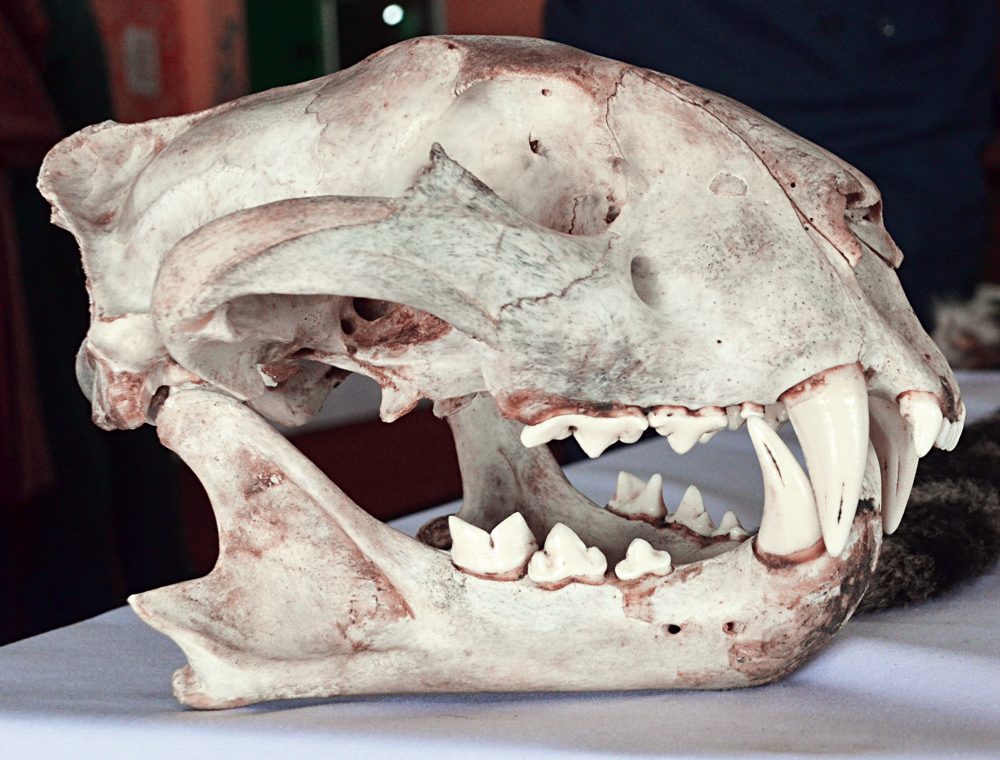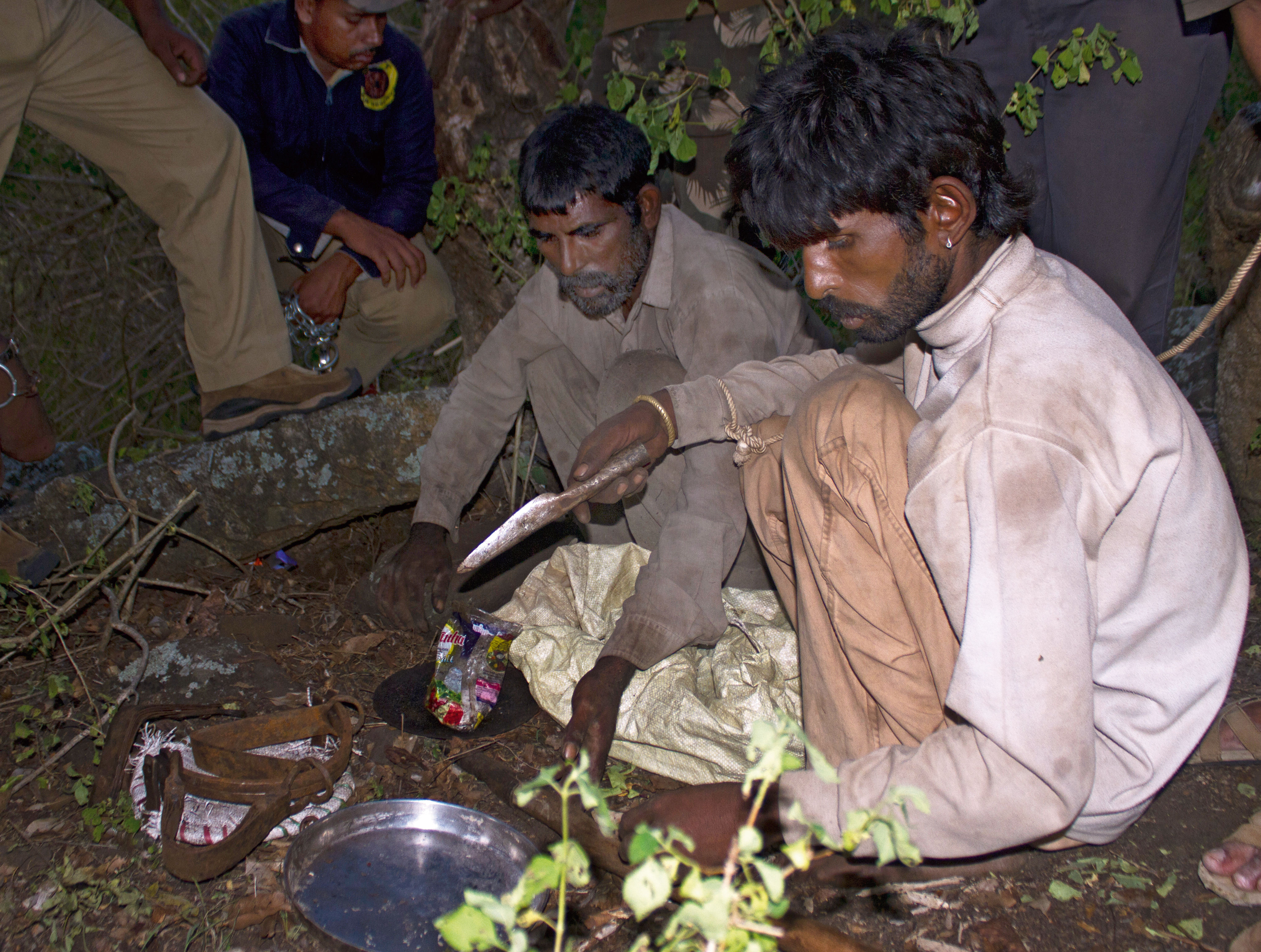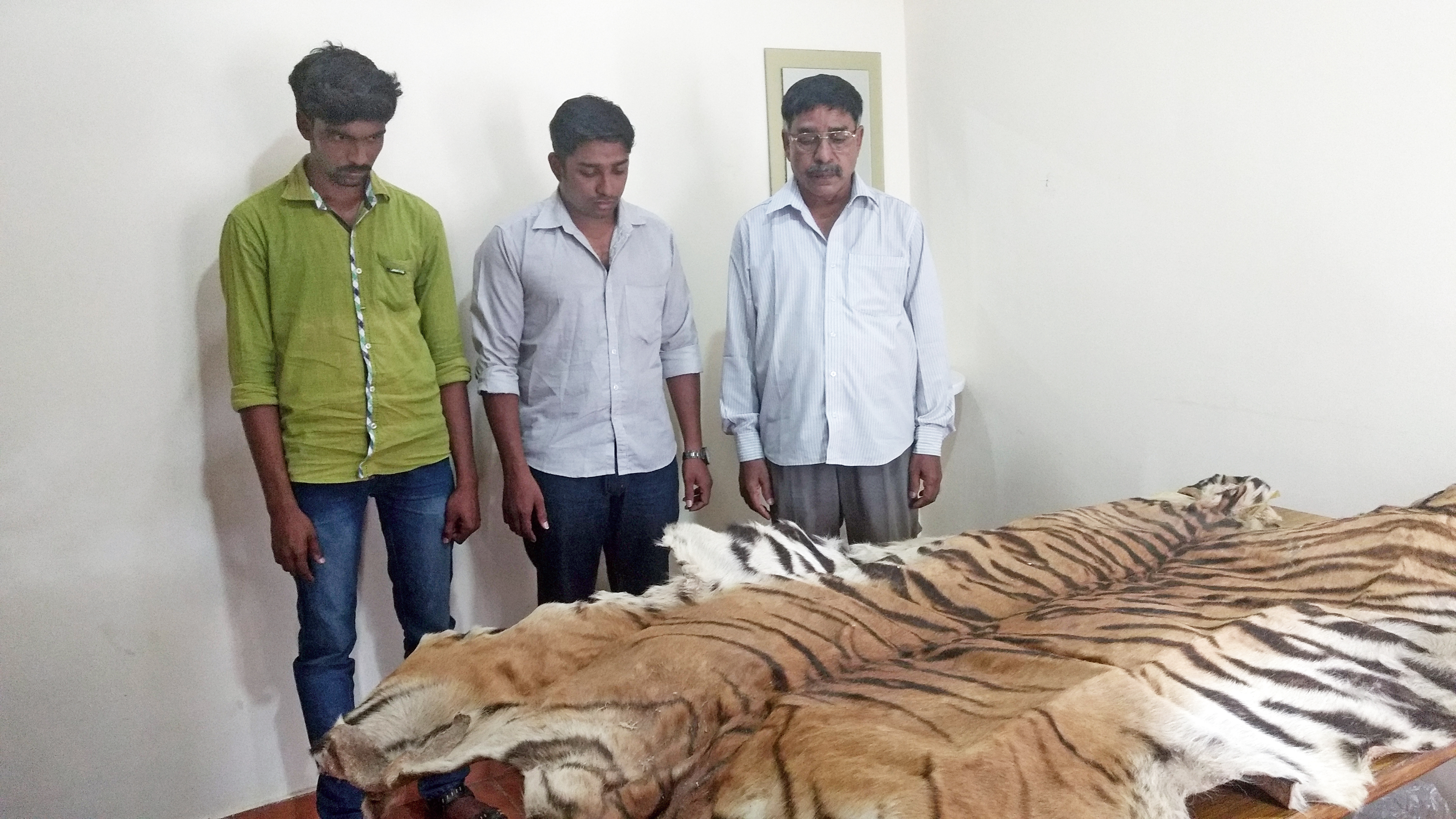Length Of Skin, Weight Of Bones
First published in Sanctuary Asia,
Vol. 37
No. 2,
February 2017
By Jose Louies
"Babuji, the forest is like a bank account for us. That's where the tigers live and multiply. The bank is secured from all sides, but when there are too many tigers in an area, one or two will stray, trying to establish a new territory. That's all we need. Then we can make a ‘withdrawal. Who cares whether the tiger is old or young, for us, it is the length of its skin and the weight of its bones that matters."
It was about 12 years ago that I received this unforgettable lesson, over a shared drink and the drag of a beedi, on the sustainability of tiger hunting as a livelihood. It was the first time that I had met a pedigreed tiger poacher. He was from the Bawaria community; I was undercover with an informer, trying to strike a deal for some tiger parts. I was scared, I remember that well.
Some years later I spent a few months embedded with a group of suspected nomadic tiger hunters. I moved about with them, dressed as they were, sharing their booze, travelling without a ticket in trains. And there were more lessons to be learned, among them the fact that when it comes to the tracking and hunting of tigers, the skill of these traditional tiger poachers is unmatchable.
A Pardhi or Bawaria (call him Bhima, Kheru, Kuttu, whatever) can stalk a tiger in its own territory, walking the same paths it walks, armed with nothing but a crude knife affixed to a bamboo pole, outsmarting forest guards and modern surveillance methods. The accumulated knowledge of hundreds of years is at play here.

A tiger skull seized from poachers. Photo: Jose Louies/WTI.
Secret People
Both Pardhis and Bawarias have a long history of hunting in the jungles of India. They once served as hunting assistants to the maharajas, and later, the British big game hunters. They drove tigers and other game towards their masters, who sat around on their elephants or on their machaans, doing nothing in the hunt other than aiming a rifle and pulling the trigger - and of course, striking a grand pose with their dead prey.
The British later listed them as Denotified Tribes, largely because of their involvement in robberies and dacoities, with the victim often ending up murdered. The hunters thus became the hunted and the communities became increasingly marginalised. Today, they live a semi-nomadic life; they have their settlements in places like Katni, Kalka and Badhi, and are involved in a number of livelihoods, some of them illegal.
A Wildlife Trust of India (WTI) team interviewed a number of Pardhis in Mumbai as part of a study conducted two years ago. Some were found eking out an existence by peddling fake Ayurvedic medicines, others sold cheap toys at traffic signals. Some of the women were involved in prostitution. There was little dignity for them in that life. In the interiors of Maharasthra, some have now taken to the manufacture of illicit liquor - for instance, a settlement about 50 km. from Nagpur supplies country liquor to vendors in the city.
When they aren't doing any of this, they hunt. And in hunting they take pride.
Their formidable success as hunters, in fact, rests on this shared sense of pride and the bedrock of their community bond. When a Pardhi or Bawaria is arrested by enforcement officials, he can be rest assured that the community will take care of his family, and he will receive all the necessary support in securing bail and fighting cases in court. On the flip side, their close-knit nature is also a bulwark against betrayal - which brings with it the promise of bloodshed, or at the very least, total ostracisation by the tribe.
Hunting areas are divided up between gangs around Diwali. (Review meetings are sometimes conducted around Holi - these guys are true professionals!). Gangs move back to their native areas during the off-seasons and regroup in villages on the forest fringes to hunt in winter and summer. Stealth is one of their biggest assets in the field: unless you know the hunters by face, you won't ever actually notice them. They do not engage in any other criminal activities when a hunt is being planned. They carry documentation and identity proofs, often carefully acquired fakes that can pass the basic scrutiny of frontline enforcement officials. For all intents and purposes, they are a peaceful bunch of nomadic gypsies living out of a couple of tents, their children begging on public transport or on the streets, their women selling plastic flowers or plaster-of-paris idols of gods and goddesses by the roadside. Recently, as their camps have come under increased scrutiny, they have taken to using local temple grounds, where they get free food and shelter.
The actual hunters often arrive a few days after other community members have established themselves, having waited to hear of any trouble. Their hunting implements are secreted well away from the place they are residing, usually in the filthiest of spots to avoid possible discovery. Once they settle in, they conduct scouting trips to determine the movement of forest guards and find the best places to penetrate the forest. They target the fringes of Protected Areas, which do not have much active protection.
Several years ago, during one of my learning and training trips in the field, I spent a few weeks with one of WTIs contacts from the Pardhi clan in a village situated in a tiger corridor. In the evenings we would go out for a walk, smoking beedis, wrapped in cheap woollen blankets, listening for alarm calls from the forest. When he heard an alarm call - especially that of a chital - my Pardhi friend would freeze up, train his ears towards the sound, and declare after a few minutes the distance of the call and the direction of movement of the predator that had caused it. We would walk the next morning to the riverbed that bordered the forest and, sure enough, find pugmarks where he had predicted they would be.
Dressed as we were, like daily wage labourers, no one would have suspected us had we been potential hunters. There was no one around, in fact, to ask us what business we had near the forest.

Professional tribal tiger hunters display the traditional tools of their trade. Members of these communities have been hunting in India's jungles for hundreds of years. Photo: Nagaraj H.N.
The Jaws of Death
“Have you ever been attacked by a tiger?" I've asked this question to many suspected hunters I have encountered and I still rememberJale Singh's answer: “We know we are in dangerous territory in the forest. But I began going to the forest when I was a teenager; since then I have walked and stalked wildlife across many forests but never had a life-threatening encounter. We avoid elephants and snakes as much as we can - they are far more dangerous than tigers and leopards." Jale Singh, a Bawaria, served a three-year jail sentence in Karnataka. He's been a free man for two years now, probably doing, even as you read this, what he knows best.
The Pardhis and Bawarias are like trained guerilla warriors in the forest. And they have a sniper's patience. They spend a few days watching their target visiting waterholes, scratching and scent marking its territory. They intuitively use pug impression pads, which our trained biologists do, to estimate a tigers size or determine the time at which it has passed a particular spot.
When they are ready, they set their trap. The jaw trap or khadka, used over centuries, is the signatory equipment of professional tiger hunters from the Pardhi or Bawaria gangs. They don't use poison or guns; they trust their simple khadkas. They know that a tiger has virtually no chance of escape once those deadly jaws have snapped shut.
The trap's precise positioning is usually left to the most experienced hunter in the group. “Once in my trap, a tiger becomes a mouse," one such Pardhi master hunter from Sehore, Madhya Pradesh, proclaimed to me once. “He knows there is no escape. At times we don't have to do anything, just stand at a safe distance and watch him die from increased blood pressure and a heart attack. Otherwise we club the tiger to death, or use a spear fixed on a four-foot stick to spear it in its mouth - this helps to silence it quickly and the skin remains undamaged."
It takes just half an hour to kill a tiger this way. Skinning it takes less than two hours.
The de-skinned carcass is hidden in a nearby ditch and the bones, the most valuable items, are collected weeks or even months later, after the body has sufficiently decomposed. The hunters remove the trap, leaving the secured chain buried in the ground for the next trip. They conceal the trap in a preselected location and slip out of the forest with the skin. Only the dead tiger knows they were there.
Once out of the forest, the skin is moved towards the Indo-Nepal border. Middlemen now collect it and smuggle it across the border. The poacher travels back to his village with his gang. His share of the money is home-delivered to him, or he collects it en route. Fifteen days of work in the field should fetch him enough money to survive for a good six months where he will do nothing but drink, smoke, eat well, satisfy other biological needs and relax. When his cash reserves run low, the trade will be there, ready with the initial capital to fund the next trip.
And so the cycle will continue. Very few hunters ever become rich despite being involved in a high-profit profession. They don't save money or invest well. They remain poor and nomadic hunters while the traders who control their lives - the Sansar Chands - make the big bucks without ever setting foot in a forest.

A tiger killed by a jaw trap in the Tadoba-Andhari Tiger Reserve, Maharashtra. The Pardhis and Bawarias prefer the use of jaw traps or khadkas to trap tigers over poison or guns. Photo: Bandu Dhotre.
A Matter of Conflict
Not many established gangs of Pardhis and Bawarias operate across the country today, thanks mainly to the concerted efforts of the Wildlife Crime Control Bureau (WCCB) and the Madhya Pradesh and Maharashtra Forest Departments, with the support of the Uttar Pradesh Special Task Force.
That the operations conducted by these organisations have been successful is down to the commitment of a few individuals who have meticulously followed leads, worked with informants, and analysed and sifted through every piece of intel they have received from various sources.
“Arrests of suspects involved in the trade, the recovery of traps and tiger products is all good," says one of the WCCB investigators WTI has worked with closely. “Where we miss out most however is ensuring a good rate of convictions in trial court cases. If these people remain in jail for a few years, that will have a greater impact on their networks and activities. As it is, many of them get bail. They need money to pay their lawyers to keep them out on bail. So they do what they know best - hunt another tiger to cover their legal costs."
“Another issue is the way conflict is increasing in our forest fringes and wildlife corridor areas," he continues. “With cattle and human beings being killed by tigers, tolerance levels are going down. People poison tigers as they don't want to live in fear of an attack; the day is not far when they will even pay these tiger hunters to kill tigers."

Suspected poachers with a seized tiger skin. Beyond arrests and seizures, it is an improved rate of convictions in trial courts that will really help break the illegal wildlife trade chain. Photo: Jose Louies/WTI.
So as India's tiger numbers continue to grow, celebration must be tempered with scepticism, for, with the degradation and fragmentation of our forests, tigers are increasingly being forced to adopt migrant lifestyles, constantly moving between Protected Areas, sharing their territories with villages and farmlands and everyone residing therein. And camped there on the fringes, ever ready to make a withdrawal from the ‘bank, stands a Bhima, or a Kheru, or a Luchi or a Baro, jaw trap ready, watching, stalking, waiting for an opportune moment. All that stands between the tiger hunter and another tiger beaten or speared to death is one of those dedicated officers, sipping tea with a contact, soliciting information on where the gang was last spotted, asking: “what is the plan?"
Note: Names of active investigators and suspects have been suppressed so as not to compromise ongoing investigations.
The views expressed in this article are those of the authors and do not necessarily represent the views of Sanctuary Asia, the Sanctuary Nature Foundation, or its Editors.
Jose Louies is the Head - Enforcement Assistance and Law, Wildlife Trust of India.
First Published in Sanctuary Asia, February 2017.





